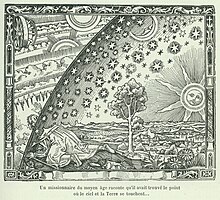Firmament

Firmament , also heavenly vault or heavenly tent , denotes in the early world views the part of the cosmos above the earth .
The firmament is the concept of capturing the sight of the visible (“blue”) sky or the starry sky and an abundance of astronomical and weather events in a protoscientific model.
The name is formed from the Latin firmamentum 'fastening means' and describes the idea that the sun and other celestial bodies and phenomena are attached to this. The firmament would then be that fixed part that still belongs to the physical sphere; Above or behind it the actual heaven begins , the localization of the supernatural and divine. The firmament then formed a separating or connecting “layer” of the earthly world to “higher” powers .
In the Babylonian worldview and in the biblical worldview that is based on it, one imagines the sky as a separation that - comparable to a huge glass bell - separates the air space of the world from the overlying primeval flood . In the German Bible, the word was therefore translated as 'festivals'.
In the ancient Greek geocentric view of the world it becomes a rotating sphere surrounding the world (earth) , or a set of concentric spheres to which the heavenly bodies, especially the " fixed stars " - hence their name - are attached (fixed star sphere). The fact that the firmament would have to encompass several mutually movable shells follows from the theories mathematically formulated by the Sumerians about the movement paths of the planets and especially the moon, which deviate from the fixed star sky . Originally one had imagined the latter as - not fixed - " wandering stars ", which then requires a supernatural being to control them, or concepts of a heavenly chariot and the like. There are notions of chariots, handlebars and star carriers in all ancient cultures, which are still present in some constellations today.
Other celestial mechanical and vision problems were also attempted to explain with higher beings, such as the figure called Atlas by the Greeks , which temporarily lifts the firmament at one end (to explain the effect of the obliqueness of the ecliptic ). The philosophical ancient astronomy in the tradition of Aristotle , which sought to get along without - arbitrarily acting - higher powers, therefore required a more complex mechanical structure of the firmament.
The idea of what was physically fixed was then broken with the theories of Johannes Kepler and his predecessors and successors, who were able to describe the laws but not the causes (in his Harmonia Mundi, Kepler favors structures in the form of Platonic solids as carriers of the orbits and the long-range effects ). According to the ether theories of the 19th century (the Greek word aither means "blue sky" and describes an electromechanically active basic substance of " space ") it was only the generation of Albert Einstein who succeeded in formulating a cosmological model that could be used without an explicit "carrier" the body gets by: Here, matter , space-time continuum and gravitation are understood as an interacting dynamic system, the respective influence of which determines the positions in relation to one another.
The phenomenological problem of seeing still exists today in the name of the celestial sphere of astronomy: This is a spherical shell around the earth, imagined as an infinitely distant one , which serves as a mapping plane when projective geometry is used ( spherical astronomy ).
